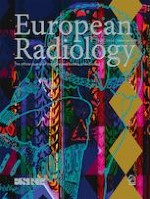16-06-2022 | Computed Tomography | Hepatobiliary-Pancreas
CT-based clinico-radiological nomograms for prognosis prediction in patients with intrahepatic mass-forming cholangiocarcinoma: a multi-institutional study
Published in: European Radiology | Issue 12/2022
Login to get accessAbstract
Objectives
To establish prognostic nomograms based on CT imaging features for predicting the prognosis in patients with intrahepatic mass-forming cholangiocarcinoma (IMCC) before and after surgery.
Methods
Two models were established for overall survival (OS) prediction in a training set (179 IMCC patients underwent surgery at institution 1 from 2009 to 2019): imaging-based nomogram included imaging features and clinical characteristics acquired before surgery; postoperative nomogram included imaging-based score, equal to the linear predictor of the imaging-based nomogram, and pathological parameters. Both prognostic nomograms were validated in an independent external dataset (103 IMCC patients received surgical treatment at two independent institutions from 2009 to 2019). Predictive performance and discrimination were evaluated and compared with the common prognostic models.
Results
The imaging-based nomogram was developed according to preoperative serum carbohydrate antigen 19-9 and four imaging features including multiple nodules, arterial enhancement pattern, CT-reported lymph node (LN) metastasis, and capsular retraction; the postoperative nomogram was built based on the imaging-based score and three pathological parameters including tumor differentiation grade, capsular invasion, and LN status. Both nomograms presented improved prognostic performance and discrimination (concordance index, 0.770–0.812; integrated Brier score, 0.120–0.138) compared with the common prognostic models in the training and external validation datasets. Besides, the nomograms stratified IMCC patients into two risk strata for OS.
Conclusions
Nomograms based on CT imaging features can provide accurate individual survival prediction for IMCC patients before and after surgery, which may help to improve personalized treatment.
Key Points
• Imaging features including multiple nodules, arterial enhancement pattern, CT-reported LN metastasis, and capsular retraction were poor independent prognostic factors for IMCC patients.
• The imaging-based nomograms presented improved prognostic performance and discrimination compared with the common prognostic models.
• The nomograms can provide accurate individual survival prediction for IMCC patients before and after surgery.





